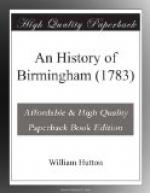One croft to find bell-ropes.
Richard Dukesayle, in 1630, gave the utensils belonging to the communion table.
Barnaby Smith, 1633, gave 20_l_. to be lent to ten poor tradesmen, at the discretion of the church-wardens for two or three years.
Catharine Roberts, wife of Barnaby Smith, in 1642, gave 20_l_. the interest of which was to be given to the poor, the first Friday in Lent.
John Jennens, 1651, gave 2_l_. 10s. for the use of the poor, born and living in Birmingham; and also 20s. on St. Thomas’s day.
John Milward gave 26_l_ per annum, lying in Bordesley: one third to the school-master of Birmingham, (Free-school); one third to the Principal of Brazen nose College, Oxford, for the maintenance of one scholar from Birmingham or Haverfordwest, and the remainder to the poor.
Joseph Pemberton gave 40s. per annum, payable out of an estate at Tamworth, and 20s. out of an estate in Harbourne.
Richard Smallbrook gave to the poor of Birmingham 10s. per annum, arising out of a salt vat in Droitwich.
Robert Whittall gave the pall, or beere cloth.
Widow Cooper, of the Talbot, No. 20, in High-street, gave one towel and one sheet, to wrap the poor in the grave.
Mrs. Jennens gave 10_l_. per annum to support a lecture, the second and third Thursday in every month.
The following offspring of charity seems to have expired at its birth, but rose from the dead a few months ago, after an internment of fifty-four years.
The numerous family of Piddock flourished in great opulence for many ages, and though they were not lords of a manor, they were as rich as those who were: they yet boast, that their ancestors could walk seven miles upon their own land. It sometimes may be prudent, however, to believe only half what a man says; besides, a person with tolerable vigour of limb, might contrive to walk seven miles upon his own land, if he has but one acre—a lawyer is not the only man who can double.
Perhaps they were possessed of the northern part of this parish, from Birmingham-heath to Shirland-brook, exclusive of many estates in the manors of Smethwick and Oldbury.
Their decline continued many years, till one of them, in 1771, extinguished their greatness by a single dash of his pen, in selling the last foot of land.—I know some of them now in distress.
William Piddock, in 1728, devised his farm at Winson-green, about nine acres, to his wife Sarah, during life, and at her death, to his nephews and executors William and John Riddall, their heirs and assigns for ever, in trust, for educating and putting out poor boys of Birmingham; or other discretional charities in the same parish.
But William and John wisely considered, that they could not put the money into any pocket sooner than their own; that as the estate was in the family it was needless to disturb it; that as the will was not known to the world, there was no necessity to publish it; and, as it gave them a discretional power of disposal, they might as well consider themselves the poor, for they were both in the parish.




